
Salmonidae is a family of ray-finned fish, the only living family currently placed in the order Salmoniformes. It includes salmon, trout, chars, freshwater whitefishes, and graylings, which collectively are known as the salmonids. The Atlantic salmon and trout of the genus Salmo give the family and order their names.

The yellow-billed cuckoo is a cuckoo. Common folk-names for this bird in the southern United States are rain crow and storm crow. These likely refer to the bird's habit of calling on hot days, often presaging rain or thunderstorms.

The Endangered Species Act of 1973 is the primary law in the United States for protecting imperiled species. Designed to protect critically imperiled species from extinction as a "consequence of economic growth and development untempered by adequate concern and conservation", the ESA was signed into law by President Richard Nixon on December 28, 1973. The U.S. Supreme Court called it “the most comprehensive legislation for the preservation of endangered species enacted by any nation.” The purposes of the ESA are two-fold: to prevent extinction and to recover species to the point where the law's protections are not needed. It therefore “protect[s] species and the ecosystems upon which they depend" through different mechanisms. For example, section 4 requires the agencies overseeing the Act to designate imperiled species as threatened or endangered. Section 9 prohibits unlawful ‘take,’ of such species, which means to “harass, harm, hunt...” Section 7 directs federal agencies to use their authorities to help conserve listed species. The Act also serves as the enacting legislation to carry out the provisions outlined in The Convention on International Trade in Endangered Species of Wild Fauna and Flora (CITES). The U.S. Supreme Court found that "the plain intent of Congress in enacting" the ESA "was to halt and reverse the trend toward species extinction, whatever the cost." The Act is administered by two federal agencies, the United States Fish and Wildlife Service (FWS) and the National Marine Fisheries Service (NMFS). FWS and NMFS have been delegated the authority to promulgate rules in the Code of Federal Regulations to implement the provisions of the Act.

The California tiger salamander is a vulnerable amphibian native to California. It is a mole salamander. Previously considered to be a subspecies of the tiger salamander, the California tiger salamander was recently designated a separate species again. The California tiger salamander distinct population segment (DPS) in Sonoma County and the Santa Barbara County DPS are listed as federally endangered, while the Central California DPS is listed as federally threatened. The Sonoma County, south San Joaquin, and the Santa Barbara County DPS have diverged from the rest of the California tiger salamander populations for over one million years, since the Pleistocene and they may warrant status as separate species.

The rainbow trout is a trout and species of salmonid native to cold-water tributaries of the Pacific Ocean in Asia and North America. The steelhead is an anadromous (sea-run) form of the coastal rainbow trout(O. m. irideus) or Columbia River redband trout (O. m. gairdneri) that usually returns to fresh water to spawn after living two to three years in the ocean. Freshwater forms that have been introduced into the Great Lakes and migrate into tributaries to spawn are also called steelhead.
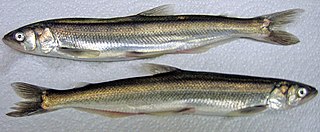
The eulachon, also called the candlefish, is a small anadromous ocean fish, a smelt found along the Pacific coast of North America from northern California to Alaska.

The coho salmon is a species of anadromous fish in the salmon family, one of the several species of Pacific salmon. Coho salmon are also known as silver salmon or "silvers". The scientific species name is based on the Russian common name kizhuch (кижуч).

Oncorhynchus is a genus of fish in the family Salmonidae; it contains the Pacific salmon and Pacific trout. The name of the genus is derived from the Greek ὄγκος + ῥύγχος, in reference to the hooked jaws of males in the mating season.

Nicasio Reservoir is a shallow, artificial reservoir in the Nicasio Valley region of Marin County, California, United States. It covers 845 acres (3.42 km2) and sits in a 35.9 square miles (93 km2) drainage basin. It was created by the construction of Seeger Dam on the Nicasio Creek in 1961. Seeger Dam is a 115-foot (35 m) tall, 400-foot (120 m) long earthen dam owned by the Marin Municipal Water District.
An evolutionarily significant unit (ESU) is a population of organisms that is considered distinct for purposes of conservation. Delineating ESUs is important when considering conservation action. This term can apply to any species, subspecies, geographic race, or population. Often the term "species" is used rather than ESU, even when an ESU is more technically considered a subspecies or variety rather than a biological species proper. In marine animals the term "stock" is often used as well.

The Atlantic sturgeon is a member of the family Acipenseridae and along with other sturgeon it is sometimes considered a living fossil. The Atlantic sturgeon is one of two subspecies of A. oxyrinchus, the other being the Gulf sturgeon. The main range of the Atlantic sturgeon is in eastern North America, extending from New Brunswick, Canada, to the eastern coast of Florida, United States. A disjunct population occurs in the Baltic region of Europe. The Atlantic sturgeon was in great abundance when the first European settlers came to North America, but has since declined due to overfishing and water pollution. It is considered threatened, endangered, and even locally extinct in many of its original habitats. The fish can reach 60 years of age, 15 ft (4.6 m) in length and over 800 lb (360 kg) in weight.

The canary rockfish is a rockfish of the northeast Pacific Ocean, found from south of Shelikof Strait in the eastern Gulf of Alaska to Punta Colonet in northern Baja California.
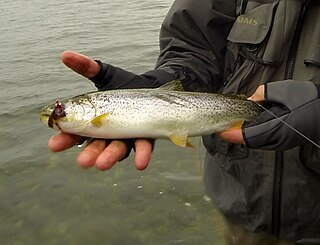
The coastal cutthroat trout also known as the sea-run cutthroat trout, blue-back trout or harvest trout is one of the several subspecies of cutthroat trout found in Western North America. The coastal cutthroat trout occurs in four distinct forms. A semi-anadromous or sea-run form is the most well known. Freshwater forms occur in both large and small rivers and streams and lake environments. The native range of the coastal cutthroat trout extends south from the southern coastline of the Kenai Peninsula in Alaska to the Eel River in Northern California. Coastal cutthroat trout are resident in tributary streams and rivers of the Pacific basin and are rarely found more than 100 miles (160 km) from the ocean.
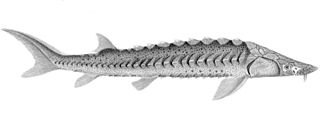
The green sturgeon is a species of sturgeon native to the Pacific Ocean, from China and Russia, over into Canada and the United States.

The bocaccio is a northeast Pacific species in the Sebastidae (rockfish) family. Other names for this species include salmon grouper, grouper, tom cod (juveniles), and slimy. In Greek, sebastes means "magnificent", and paucispinis is Latin for "having few spines".
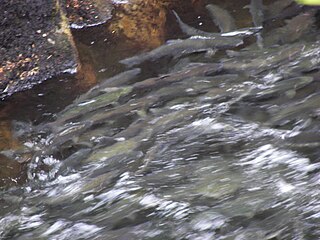
The survival of wild salmon relies heavily on them having suitable habitat for spawning and rearing of their young. This habitat is the main concern for conservationists everywhere. Salmon habitat can be degraded by many different factors including land development, timber harvest, or resource extraction. These threats bring about the traditional methods of protecting the salmon, but a new movement aims to protect the habitats before they require intervention.
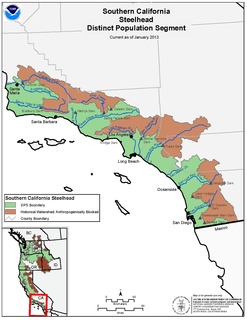
The Southern California Steelhead Distinct Population Segment (DPS) occurs from the Santa Maria River to the Tijuana River at the United States and Mexican Border in seasonally accessible rivers and streams. Steelhead in the Southern California Steelhead DPS, much like its relatives further north, requires sufficient flows in their natal streams to be able to return from oceans and lakes to spawn. Due to the extended periods of drought throughout their range, Southern California steelhead are most commonly seen during periods of increased rainfall, such as El Niño events. Declared federally endangered in 1997, the geographic range of the DPS when first listed extended from the Santa Maria River south to Malibu Creek. In 2002 steelhead were discovered in San Mateo Creek on the county line of Orange and San Diego counties. With this discovery the range of the DPS was extended to include Los Angeles, Orange, and San Diego counties.<67 FR 21586, May 1, 2002> "Saving the Southern California Steelhead Trout". Center for Biological Diversity. Retrieved 2013-03-16.</ref>

A Habitat Conservation Plan (HCP) is a required part of an application for an Incidental Take Permit, a permit issued under the United States Endangered Species Act (ESA) to private entities undertaking projects that might result in the destruction of an endangered or threatened species. It is a planning document that ensures that the anticipated take of a listed species will be minimized or mitigated by conserving the habitat upon which the species depend, thereby contributing to the recovery of the species as a whole.
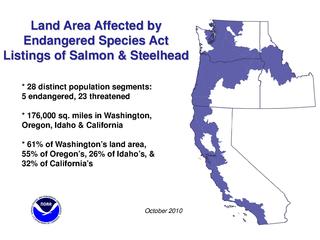
The National Oceanic and Atmospheric Administration, in cooperation with the U.S. Fish and Wildlife Service and Environmental Protection Agency, groups steelhead and salmon into distinct population segments (DPS). There are currently 15 DPS for steelhead and 31 evolutionarily significant units (ESU) for five species of Pacific salmon Oncorhynchus. The boundaries of these areas are used to determine whether specific populations of a species should be designated threatened or endangered species under the Endangered Species Act.

The loggerhead sea turtle, is protected under the Endangered Species Act (ESA) of 1973. It was originally listed as a threatened species on July 28, 1978. The loggerhead turtle is the most prolific species of sea turtle in U.S. coastal waters.
Waples, R.S. 1991. Definition of 'species' under the Endangered Species Act: Application to Pacific salmon. U.S. Dept. Commerce, NOAA Tech Memo. NMFS, F/NWC-194.
United States Fish and Wildlife Service, and National Marine Fisheries Service. 1996. Policy regarding the recognition of distinct vertebrate population segments under the Endangered Species Act. Federal Register (7 February 1996)61(26):4722-4725.


















